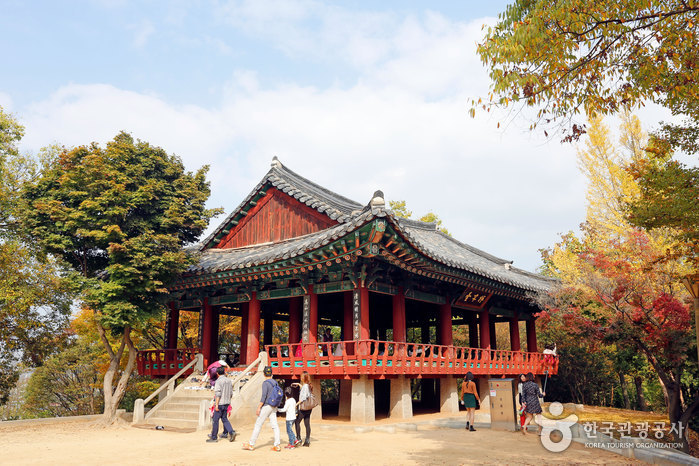Damun (다문)
451.22458416782416m 8127 2024-04-07
74-8, Eunhaeng-ro, Wansan-gu, Jeonju-si, Jeonbuk-do
+82-63-288-8607
Situated in Jeonju Hanok Village, Gyo-dong, Jeonju-si, Damun serves Korean table d’hote in a restaurant divided into large and small rooms within a hanok building structure.
Yeohangga [Korea Quality] / 여행가 [한국관광 품질인증]
451.72172262469536m 9718 2024-04-07
74-11 , Eunhaeng-ro, Wansan-gu, Jeonju-si, Jeonbuk-do
+82-63-231-3040, +82-10-7742-6738
The Traveler, located in Jeonju, Jeollabuk-do, is a pleasant place to stay for families in particular. Apart from the charm of staying in a hanok, visitors can experience traditional games of chance like the Twelve Bridges Game and the Pumpkin Wheel Game. Each room is equipped with a bathroom/toilet, and residents can use the kitchen in the main house to prepare meals.
Omokdae and Imokdae Historic Sites (오목대와 이목대)
457.9243494602178m 27949 2024-04-07
55 Girin-daero, Wansan-gu, Jeonju-si, Jeonbuk-do
+82-63-281-2114
Omokdae Historic Site is located on top of a steep hill and is one of the places where Yi Seong-gye, who later became King Taejo, the first king of the Joseon dynasty, stopped to celebrate his victory on his way home from a war against the Japanese army at Unbong Peak of Hwangsan Mountain. Across the bridge from Omokdae is Imokdae Historic Site, situated at the foot of Seungamsan Mountain. Approximately 80 meters downhill from Imokdae are memorial stones and a building where Mokjo, the great-great-grandfather of King Taejo, once used to live. The engraved letters on the stones are the handwritings of Emperor Gojong. Mokjo moved to Hamgyeongdo as a result of a dispute with the then minister of Jeonju, an incident which King Taejo believed to have laid the foundation for him to shape the Joseon dynasty.
Jeonju Pungnammun Gate (전주 풍남문)
458.7474803939587m 29321 2024-04-07
1, Pungnammun 3-gil, Wansan-gu, Jeonju-si, Jeonbuk-do
+82-63-287-6008
Pungnammun Gate was built during the Joseon dynasty in 1734 and is a designated Treasure. Pungnammun Gate was the southernmost gate among the four city gates of Jeonju. The structure was severely damaged by fire in 1767, followed by the restoration of the gate tower afterward. The gate was burnt down once again during the Imjin War and was restored to the gate that is seen today.
Gyodonggaon [Korea Quality] / 교동가온 [한국관광 품질인증]
467.36922697601176m 7286 2024-04-07
73-1 , Eunhaeng-ro, Wansan-gu, Jeonju-si, Jeonbuk-do
+82-63-231-2355, +82-10-5106-3355
Gyodong Gaon is a two-story hanok stay on the main street of Jeonju Hanok Village, Jeollabuk-do. The yard contains a small garden, a jangdokdae (jar stand), a furnace and a mural that has become a popular place for photos. The upper floor guestroom Numaru (‘Loft’) offers a panorama of the village. The first floor Meomulda (‘Lodging’) guestroom has a door between bedroom and living room. Nanuda (‘Sharing’) on the 2nd floor is the largest room, while Damda (‘Contain’) and Ggumggu (‘Dreaming’) both have attics. Finally, Geurida (’Drawing’) is a room with a fine view. Traditional games such as Hoops and Tuho can be played without charge.
Wookssam Jageopsil [Tax Refund Shop] (욱샘작업실)
470.0920735601816m 0 2024-04-23
20 Hyeonmu 1-gil, Wansan-gu, Jeonju-si, Jeollabuk-do
-
Geumhong Handicraft [Tax Refund Shop] (금홍공예)
470.0920735601816m 0 2024-04-22
20, Hyeonmu 1-gil, Wansan-gu, Jeonju-si, Jeollabuk-do
-
Gongjakbuini Gongjakhan Gongjak [Tax Refund Shop] (공작부인이공작한공작)
470.0920735601816m 0 2024-04-19
20, Hyeonmu 1-gil, Wansan-gu, Jeonju-si, Jeollabuk-do
-
Hanok Stay Kkachi [Korea Quality] 한옥스테이 까치[한국관광 품질인증]
471.8526640524945m 1 2024-04-07
74-5, Eunhaeng-ro, Wansan-gu, Jeonju-si, Jeonbuk-do
+82-504-0904-2640
Kkachi (‘Magpie’) is a private hanok stay in Jeonju Hanok Village, Jeollabuk-do. This house has been painstakingly remodelled by the owner to create a stylish and relaxing space inside a hanok frame. The result is a merger of the traditional hanok style with modern convenience, such as the large number of windows which bring light into the space. In the garden, guests will find seating and a footbath, while a pool for children can be rented.
Jeondong Catholic Cathedral (전주 전동성당)
480.0781211393631m 52000 2024-04-07
51 Taejo-ro, Wansan-gu, Jeonju-si, Jeonbuk-do
Jeondong Catholic Cathedral in Jeonju (Historic Site) was built in honor of Roman Catholic martyrs of the Joseon dynasty on the very same spot the martyrs lost their lives. The land was purchased by French Priest Baudenet in 1891 (28th year of King Gojong), but construction of the church did not begin until 1908. The church was designed by Priest Poinel, who also designed the famous Myeongdong Cathedral in Seoul. Construction was completed in 1914, a time during which Korea was under Japanese rule. Though originally built just outside of Pungnammun Gate, the site of the martyrs, the church was later moved to its current location for expansion.
The first Romanesque building in the Honam region, Jeondong Catholic Cathedral is made of gray and red bricks and bears a striking resemblance to the Myeongdong Cathedral in Seoul. Not only considered one of the most beautiful Catholic churches in Korea, some even go so far as to say it is one of the most beautiful structures in all of Korea, citing the church’s unique combination of Byzantine and Romanesque architectural styles. The rectangular building is topped with three Byzantine bell towers (to the right, center, and left) and boasts arched ceilings, several of which meet in the form of a cross.
It is interesting to note that some of the bricks used in construction of the church were made using materials from the Jeonjueupseong Walled Town, which was torn down by the Japanese. It is also said that the cornerstone of the church came from a wall of Jeonjueupseong Walled Town near Pungnammun Gate.

![Yeohangga [Korea Quality] / 여행가 [한국관광 품질인증]](http://tong.visitkorea.or.kr/cms/resource/63/2572563_image2_1.jpg)


![Gyodonggaon [Korea Quality] / 교동가온 [한국관광 품질인증]](http://tong.visitkorea.or.kr/cms/resource/75/2049675_image2_1.jpg)

![Hanok Stay Kkachi [Korea Quality] 한옥스테이 까치[한국관광 품질인증]](http://tong.visitkorea.or.kr/cms/resource/39/3009439_image2_1.jpg)

 English
English
 한국어
한국어 日本語
日本語 中文(简体)
中文(简体) Deutsch
Deutsch Français
Français Español
Español Русский
Русский